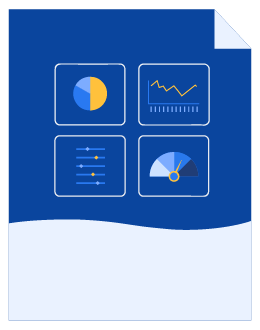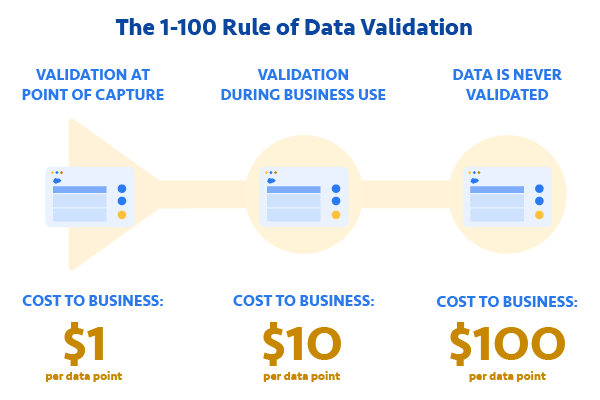Risks of Poor Sales Data Quality and How to Improve Your Data


Chris Villa
There are many consequences associated with poor-quality sales data, including under-preparing your sales representatives and creating inaccurate buyer personas. In fact, one recent study shows that inaccurate B2B data wastes 27.3% of a sales rep’s time on average.
In this article, we’ll discuss the risks associated with using bad B2B prospect data:
- Wasted time and money
- Unprepared salespeople
- Misinformed buyer personas
- Lower morale in the organization
We’ll also cover a few best practices to ensure you’re improving your data quality, such as how to collect quality data from the get-go and ways to perform data hygiene.

Beginner’s Guide to B2B Sales Data Management
Learn everything you need to know about collecting prospect data and maintaining the health of your database.
What is bad data?
First, let’s define what bad data is. Bad sales data includes incorrect or incomplete information that you have on your prospects and customers that can negatively affect all facets of your sales and marketing efforts.
A few examples of bad data include:
- Missing contact fields
- Data entered in the wrong field
- Typos and spelling errors
- Inaccuracies due to outdated information
- Duplicate entries
- Incorrectly or inconsistently formatted data
Low-quality data is harmful because it misinforms your sales and marketing teams when they are approaching potential customers, which can negatively impact both conversion rates and your brand’s reputation.
The cost of bad data
To prove how exponentially expensive it is to use inaccurate data, CEO George Labovitz and Dr. Yu Sang Chang proposed the 1-10-100 rule, which states as follow:
It takes $1 per contact to prevent any bad data at the point of capture. These prevention methods include using automation like CRM, only purchasing prospect data from high-quality data providers, and creating a playbook to enforce standards.
To correct any mistakes made in the database, the cost rises to $10 per contact. From spending extra time to correct data formatting issues to verifying each contact’s accuracy, the correction cost includes all the costs associated with validating a dataset.
If you continue to utilize bad data, the cost increases to $100 per contact. This failure cost covers everything from all the wasted opportunities you lost to poor decision-making based on bad data.

The key takeaway here is that it simply costs less to start with quality data than it does to try and fail to utilize inaccurate data.
How does dirty data affect sales?
Using low-quality prospect data makes your salespeople’s job more difficult because your sales team ends up spending more time verifying leads than actually closing deals. From manually calling to validate each lead to searching up relevant information about the prospect’s company, your team would be wasting valuable time just trying to figure out who to contact.
Not only do they have to spend more time confirming contacts, the sales team also risks chasing prospects who have little chance of converting.
Using bad data also hurts prospect relationships. One study shows that over 80% of B2B decision-makers feel that the SDRs were unprepared when they first connected.
A few examples of being unprepared include:
- Not understanding the industry prospects operate in and their relevant pain points
- Not knowing prospects’ annual revenue (which means a sales rep may be pitching a solution that’s out of budget)
- Contacting a person in the company who doesn’t have a clear connection to the decision-maker
Another consequence of using bad data is that you decrease morale in your team. A misguided sales team means they won’t be able to close deals effectively. Since sales teams often earn money through commission, this will inevitably frustrate your sales team because they feel like they aren’t equipped with the right information.
A strong sales team can be key to your organization’s success, so it’s important to invest in high-quality data that will help them excel.
If you need help building out comprehensive and consistent prospect data, we created a free sales prospect list template for you to download and use.
How does dirty data affect marketing?
In the marketing world, data informs everything from measuring the success of a campaign to creating an effective strategy that reaches relevant prospects. Unfortunately, 62% of organizations rely on marketing or prospect data that is 20-40% inaccurate or incomplete.
You need to create well-defined buyer personas to create meaningful touchpoints for your prospects. To create accurate personas, you need data to identify patterns within your analytics. Therefore, your marketing team will risk completely misunderstanding your prospects whenever they use inaccurate information.
Continuing to utilize bad data means you’ll end up creating ineffective campaigns. For example, email marketing heavily relies on an accurate segmented list of prospects. Using bad data will increase your risk of creating mismatched messaging, which increases your subscriber churn rate.
As it takes more money to gain a lead than to retain one, having a high churn rate means you’re wasting money and losing valuable leads.
Worst of all: you’ll leave a bad impression on your prospects, which decreases the chance they’ll move further along the buyer’s journey. Since their pain points aren’t answered by your marketing campaigns, they’ll start to look to your competitors’ solutions.
How to improve prospect data quality
Now that you know the consequences of using bad data, let’s talk about how to avoid these risks. From starting with high-quality data to performing regular data hygiene, we have a few tips for you.
Start with high-quality data
Prevention is key to reducing the risks associated with bad prospect data. However, building out an accurate prospect database can be a tedious process.
That’s why some organizations choose to purchase a list from a data provider. However, it’s important to be critical of the provider you purchase from. Some data providers are so focused on trying to get as much data in as possible that they include decayed data.
At EBQ, we have perfected our approach to collecting accurate prospect data over the years. While we’ve created proprietary processes to automate our data collection, our data is still human-curated and sourced from high-quality sources to ensure the accuracy of our data.
Since human error is one of the biggest culprits to bad data, we also recommend utilizing your CRM tool to take advantage of its preventative measures–such as data validation and duplicate data alerts.
However, it’s not enough to just rely on CRM tools to maintain data standards.
Enforce data integrity
To ensure everyone in your organization is on the same page, you need to develop a playbook for data standardization. This playbook should cover everything from how to use the CRM tool for your unique process, to key definitions of data fields and how they should be used.
A database playbook should cover key definitions and processes, such as:
- Industries (and which verticals are included in them)
- Company size ranges (e.g. 201-500, under 50, etc.)
- Address formatting (e.g. simply putting “TX” or spelling out the state as “Texas”)
- Phone number formatting (e.g. (123) 456-7890 or 123456789)
For example, one way we keep our data clean is by standardizing industries and vertical names for nearly every type of business—the 30 different industries we can target are broken up into 700+ named verticals.
To break it down further, there are key differences between what’s considered a “clinic” and what’s considered a “hospital.” Although they’re both related to the health industry, selling to a small clinic versus a university hospital has vastly different approaches.
Since the industry names and formatting have been standardized, we’re effectively able to pull insights about which industry verticals we see the most success with.
…but allow changes to happen
As businesses grow, processes inevitably evolve. That’s why it’s important to create standards that are flexible enough to be updated from time to time.
One example is when you understand how you need to further segment prospects from a large industry based on the feedback you get from your sales team. If you service the auto industry, you might want to distinguish prospects who are running a car wash company from an auto shop.
These segments will allow you to create better strategies that help both your sales and marketing teams target prospects who are most likely to convert and with the right messaging.
Perform data hygiene
High-quality data is not just a one-time investment—data does decay over time. When you look exclusively at B2B data, the decay rate is estimated to be 70.3% per year.
That’s why it’s important to set aside time to evaluate the health of your prospect database. However, this is a tedious task, as data scientists estimate they spend 50-80% of their time just cleaning data.
That’s why some organizations choose to invest in a third-party data scrubbing service. While the third-party firm focuses on validating data, your team can focus on building stronger relationships with potential clients.

Beginner’s Guide to B2B Sales Data Management
Learn everything you need to know about collecting prospect data and maintaining the health of your database.
Empower your teams with high-quality data
Data ultimately drives both sales and marketing strategies. By utilizing bad data, you are not only wasting your money trying to mitigate the impacts of bad data, but you are also leaving a bad impression on prospects who matter.
Internally, you’ll also see a drop in morale as both the sales and marketing teams can not perform to the best of their abilities.
By investing in data hygiene, you can ensure that you are reaching the right people with the right message, which leads to closing more deals.
Many of the clients we work with at EBQ previously wasted significant time and money using inaccurate sales data. If you want high-quality prospect data built and verified by experts, connect with our data specialists today.
